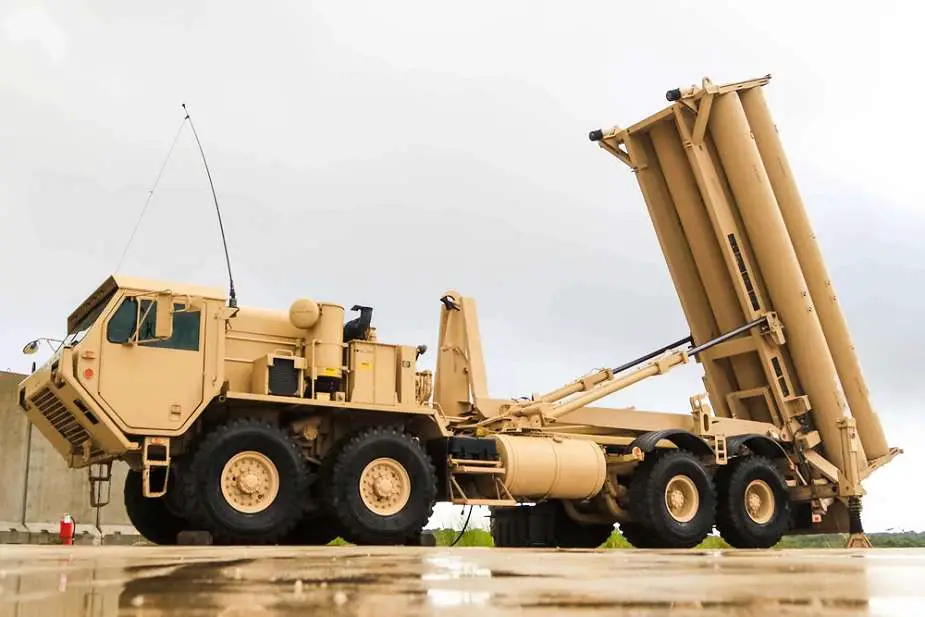Breaking news
US Deploys 6 THAAD Air Defense Missile Systems in Guam To Counter China - North Korea Threats.
The United States has strategically deployed six Terminal High Altitude Area Defense (THAAD) air defense missile systems at Site Excalibur, located near the U.S. Marine Corps' newest base in Guam. This move, as reported by the "Star & Stripes" website on December 29, 2023, marks a critical step in strengthening air defense capabilities in the Northwest Pacific. Guam, a key U.S. territory, lies approximately 5,310 km west of Hawaii and 2,400 km east of the Philippines, positioning it strategically south of Japan.
Follow Army Recognition on Google News at this link

A Terminal High Altitude Area Defense or (THAAD) launcher vehicle assigned to Task Force Talon, 94th Army Air and Missile Defense Command. (Picture source U.S. DoD)
This deployment is primarily seen as a countermeasure to potential threats from nations like China and North Korea, addressing concerns over ballistic, cruise, and hypersonic missiles. The THAAD units are part of the U.S. Army’s 38th Air Defense Artillery Brigade, based in Sagamihara, Japan. The Guam deployment includes about 200 soldiers, supplemented by an additional 100 personnel operating Japan-based radars. Along with the THAAD launchers, the site also features sophisticated radar systems, command and communications equipment, and a fleet of armored vehicles.
Site Excalibur is more than just a deployment location; it represents a cornerstone in the U.S.'s broader plan to establish a comprehensive 360-degree missile defense system across Guam. The Missile Defense Agency outlines an ambitious goal for the system to be fully operational by 2027, encompassing up to 20 sites across the island. This initiative is a clear indication of the United States' commitment to maintaining a strong defensive posture in the Pacific, ensuring the security of its territories and allies in the region.
The Terminal High Altitude Area Defense (THAAD) system is a sophisticated component of the United States' missile defense strategy, specifically designed to counter a variety of threats, including short, medium, and intermediate-range ballistic missiles. It operates in the terminal phase of missile flight, effectively intercepting and destroying incoming threats at high altitudes, thus minimizing the impact of potential weapons of mass destruction. THAAD's advanced technology comprises five key elements: launchers, interceptors, radar, a fire control unit, and necessary support equipment. The system employs a hit-to-kill approach, using kinetic energy to neutralize missiles, eliminating the need for explosive warheads. This method is a significant advancement in missile defense technology.
THAAD's engagement capabilities are impressive. It can intercept threats within a range of 200 kilometers and at altitudes up to 150 kilometers. The system's radar, known as the AN/TPY-2, is exceptionally capable, with a maximum detection range of up to 1,000 kilometers, allowing it to identify incoming missiles at great distances. Typically, a THAAD battery includes six launchers, each capable of firing eight interceptors, and a total of 48 interceptors per battery. The system is particularly effective against ballistic missile threats posed by countries like North Korea and Iran, and it has been deployed in strategic locations such as Guam, South Korea, and the United Arab Emirates to bolster regional defense capabilities. THAAD's interoperability with other missile defense systems like Aegis and Patriot enhances its utility, creating a comprehensive, layered defense approach. Its mobility and rapid deployability allow it to be a flexible and vital component in countering missile threats in regions of strategic importance.
Guam's strategic significance for the United States Armed Forces is multifaceted, deeply rooted in its unique geographical location and the capabilities it offers. As a U.S. territory in the Western Pacific, Guam serves as America's most forward military base in the Asia-Pacific region. This positioning is critical in a global context where the Asia-Pacific has emerged as a key arena in international politics and economics. Guam's location enables the United States to effectively project power and maintain a significant presence in this strategically vital area.
Moreover, Guam's military capabilities are a cornerstone of its strategic value. The island hosts key U.S. military installations, including Andersen Air Force Base and Naval Base Guam. These facilities are equipped to support a wide range of military operations, providing critical logistics, air, and sea support capabilities. Andersen Air Force Base is particularly crucial, as it can host large numbers of bombers and support long-range operations, making it an essential outpost for power projection. The presence of sophisticated air and naval assets in Guam enhances the United States' ability to respond quickly to regional crises, conduct surveillance, and engage in deterrence activities.
Additionally, Guam plays a pivotal role in the broader U.S. defense strategy, particularly in the context of regional security dynamics. Its presence serves as a deterrent to potential adversaries in the region and is a key component of the U.S. security umbrella that extends to allies such as Japan, South Korea, and the Philippines. In times of escalating tensions or conflict, Guam's strategic location could be crucial for rapid deployment and logistics support, thereby reinforcing the U.S. commitment to stability and peace in the Asia-Pacific region.
In summary, Guam's strategic importance to the United States Armed Forces is rooted in its geographic position, its robust military capabilities, and its role in the broader U.S. defense strategy in the Asia-Pacific region. This combination of factors makes Guam an indispensable component of U.S. military power and regional influence.
Defense News January 2024


























